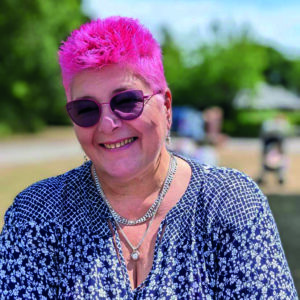
I assumed I was in so much pain because I needed another increase of drug dose; it never occurred to me that the pain medicines were not working, says Louise Trewern
 Six years ago, I went into my local community hospital for a rapid taper of high dose prescription opioids, due to my deteriorating health. I had been on prescription opioids for over 12 years for pain due to fibromyalgia and osteoarthritis. As well as severe pain, I was sensitive to absolutely everything. I couldn’t even bear the cat walking across my lap.
Six years ago, I went into my local community hospital for a rapid taper of high dose prescription opioids, due to my deteriorating health. I had been on prescription opioids for over 12 years for pain due to fibromyalgia and osteoarthritis. As well as severe pain, I was sensitive to absolutely everything. I couldn’t even bear the cat walking across my lap.
I assumed I was in so much pain because I needed another increase of drug dose; it never occurred to me that the pain medicines were not working. This only became clear after I was referred to the local Pain Rehabilitation Service.
Side effects
Over time I had started to display the long-term side effects of long-term use of opioids. I developed opioid-induced hyperalgesia which meant I was extremely sensitive to pain. I had constant infections that required antibiotics, and often more than one course. I had repeated chest infections, sinus infections, skin infections and repeated vaginal and oral thrush. I developed quite severe sleep apnoea (when breathing stops and starts while you sleep) that was only picked up by an astute physiotherapist I was seeing about another problem. She referred me and I ended up with a full-face CPAP machine – this pumps air into a mask you wear over your mouth or nose while you sleep to improve breathing.
I could not tolerate any noise so the television had to be quiet, I couldn’t listen to music and too many people talking was painful. I would not answer the phone, even to family, and I became paranoid and depressed. As I never knew how I would be on the day, I wouldn’t accept invitations and eventually friends and family stopped asking. All of this also impacted my wife, who had become my full-time carer.
Sleep was another issue for me. The pain would wake me at night and I would not be able to drop off again. This resulted in me sleeping at odd times during the day and being awake half the night.
Between appointments at the pain clinic, I had two emergency admissions to hospital for opioid-induced impaction (where poo has built up in the rectum). Since starting on opioids, I was prescribed sachets of laxative to prevent constipation, a well-known side effect, but one Friday night out of the blue I just couldn’t go to the toilet. Over the weekend I had visits from an on-call GP, a district nurse who gave me enemas to help clear my bowel, and paramedics. Eventually on Monday morning an ambulance was called and I ended up in theatre. This happened twice in quick succession.
Positive change
The emergency admissions gave the criteria to get me into community hospital for a rapid taper. I went into the hospital a zombie, who didn’t want any noise and was sensitive to absolutely everything. At the time I was on several opioids including 320mg of oxycontin plus oxycodone liquid a day, with dihydrocodeine. I had diazepam for anxiety, and sertraline and duloxetine to help the pain. But I came out at the end of the week on 20mg of oxycontin, which I stopped over the course of the month. I was a completely different person.
Commitment
Going through withdrawal from opioids was no picnic. I was advised to gradually walk down the ward, as that could trigger endorphins, the body’s natural painkiller (something I had never heard before). I popped my earphones in and paced up and down constantly. It worked, so I carried on when I got home from hospital. At first, I would take my wheelie walker to flat places like the seafront near where I live. As I got fitter, I was able to ditch the walker for walking poles and eventually no aids. I went into hospital weighing a dangerous 25 stone, and gradually I lost 8.5 stone by walking every day, eating properly and sleeping well for the first time in years.
With the combination of walking, eating well, connecting with nature, and learning self-management techniques, I came off all my multitude of opioids and drugs for pain. I now no longer need the CPAP machine, and I am happier, healthier and fitter than I have ever been. Today I manage my pain by keeping as active as possible, walking, swimming in the sea year-round and using an exercise bike.
Inspiring others
I have now worked extensively with professionals and patients within the pain arena. Learning about pain and how it works has been a linchpin for me to discover skills to self-manage my pain, and to help others go through the same process.
Useful resources
- The British Pain Society, www.britishpainsociety.org
- Flippin Pain public health campaign, www.flippinpain.co.uk
- Footsteps Festival, www.footsteps-festival.co.uk
- Live Well With Pain, www.livingwellpain.net
- Pain Killers Don’t Exist, www.painkillersdontexist.com
Keen to submit your own story? Email [email protected].
PS Did you know that Arthritis Digest Magazine is labelled the best UK Arthritis blog from thousands of blogs on the web ranked by traffic, social media followers, domain authority & freshness?
For more in-depth features, interviews and information, subscribe to Arthritis Digest magazine, a popular title that’s published six times a year. Click here for the digital version or tel 01892 354087 to order your hard copy. You’ll know what your doctor is talking about, what new drugs are in the pipeline and be up to date on helpful products.
